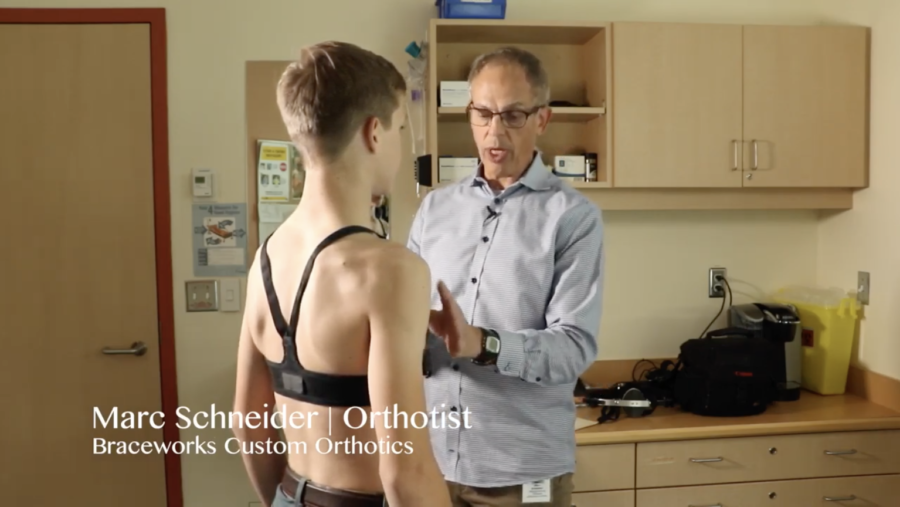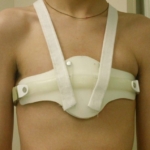Pectus carinatum – FAQs
How common is Pectus carinatum?
Pectus carinatum occurs in approximately 1 to 2 people in 3,000 and occurs more commonly in males.
Has your clinic seen many Pectus carinatum cases?
Braceworks regularly treats patients with Pectus carinatum, according to The Calgary protocol for bracing Pectus carinatum, and have successfully treated over 5000 people since 1992.
Why is it important to correct the deformity?
Correcting the deformity improves posture and self-image. In addition, treatment may also improve cardio-pulmonary function in more severe cases.
How does the Braceworks Pectus Brace work?
The Braceworks Pectus Brace® corrects the alignment of the sternum in much the same way as orthodontic braces work to correct the alignment of teeth. The brace is a very low profile device consisting of a compression pad anchored to a light-weight, aluminum bar on the front section attached to a comfortable soft back section. The front and back sections are connected at the sides by small adjustable ratcheting buckles.
The brace is worn discreetly under clothing up to 12 hours a day during the initial stage of treatment to correct the deformity. Then, wearing time is reduced to 8 hours per day, usually at night, until you reach your full height. You will be taught how to adjust the tension of the brace to maintain gentle pressure as the deformity is corrected. Parents easily learn to check if adequate pressure is being applied. Your Physician will monitor your progress at regular intervals over the course of treatment.
Will the brace hurt?
Most patients experience no discomfort wearing the Braceworks Pectus Brace®, unless they adjust the brace too tightly – causing skin irritation. Sleeping on your front during the correction phase of treatment when the brace must be worn 12 hours/day for 7 days/week may also be uncomfortable.
Is there any risk that I can tighten the brace too much and over-correct the deformity?
No. The discomfort of excessive pressure causes skin irritation that prevents this from happening.
At what age should bracing start?
The optimal time to brace is during early teenage growth when the deformity is mild to moderate and the chest wall is flexible.
How long does it take to correct the deformity?
While visible improvements are noticeable within weeks, correction is generally completed within the first 4 to 8 months of treatment wearing the brace 23 hours/day. Factors that affect the rate of correction include age (i.e., the older you are, the longer it takes) and stage of growth and development (i.e., the earlier you have a growth spurt, the shorter the correction phase).
Do I have to keep wearing the brace after the deformity is corrected?
Yes. The correction phase is followed by a maintenance phase.
How long do I have to continue wearing the brace after the deformity is corrected?
Your Physician will determine the appropriate time to transition from the initial correction phase to the maintenance phase. You physician will determine when to discontinue bracing but will generally wait until you have finished growing with height measurements stable for 2 measurements taken at 6-month intervals.
Will I still be able to play sports?
Yes. You can continue with all your normal activities including sports although we don’t recommend wearing the Braceworks Pectus Brace® during contact sports or other activities, such as snowboarding in a terrain park where there may be a risk of impact from falling.
Is the maintenance phase required?
Absolutely! Wearing the brace after the deformity is corrected is key to holding the sternum in alignment. This prevents your sternum from drifting back and the deformity re-emerging. The longer you wear the brace, the better your chances are that your sternum will remain in proper alignment.
I am in the maintenance phase and stopped wearing my brace for a few days. I noticed that the bump began to re-emerge. What should I do?
Until you have finished growing, there is a risk of the deformity recurring so you must continue to wear your brace diligently 8 hours per day or night. The deformity will recede again when you resume wearing the brace, as prescribed.
Am I too old for bracing?
The ideal time to consider treating the deformity is during the early teenage years. The effectiveness of bracing for adults is a subject for further research.
How many appointments are required to measure and fit the brace?
There are two, one-hour appointments. The first appointment is to review your diagnosis and prescription, assess your condition and take your measurements for the brace. The second appointment is to fit the Braceworks Pectus Brace® and review the wearing instructions.
What do I do if I notice that the brace doesn't seem to fit properly?
If you have problems with the deformity, contact you Physician. If you have problems with the brace, contact Braceworks, phone 403-240-9100 or email.
Where is the Braceworks Pectus Brace available?
Treatment, according to the The Calgary Protocol, is available with the help of Physicians in Australia, Canada, The United Kingdom and selected clinics worldwide.
Find a doctor – The Calgary Protocol for bracing of pectus carinatum
What if I don’t live near any of these centres?
We are actively recruiting Physicians worldwide to improve accessibility and availability of the Braceworks Pectus Brace®. Please see your Family Physician for a referral to a Thoracic Surgeon and ask them to follow up directly with us.
I don't live in Alberta. Can I still make an appointment to see you for a brace in Calgary?
Yes. We can help coordinate an appointment in Calgary for you with Dr. Steven Lopushinsky for a diagnosis and prescription, at the Alberta Children’s Hospital.
Non-residents of Alberta are charged a fee by Alberta Health Services for a consultation, which includes all laboratory and x-rays required. Additional fees may apply if CT and MRI scans are required.
How much does the Braceworks Pectus Brace cost?
The total cost of the Braceworks Pectus Brace® in Canada is $1,325.00 CAD. Fees outside Canada are $1,425.00 USD. Costs include all appointments and routine clinical fees.
Is the cost of the brace covered by public or private insurance?
Public insurance varies from one jurisdiction to another so you have to enquire with your particular paying agencies. We would be pleased to assist you by providing a detailed estimate including a description of the procedure for pre-approval by your public or private insurer provider.
How can I access your product, if I am willing to pay for the brace personally or through private insurance?
I have been denied access to this treatment and offered an inferior alternative. I have been informed the Braceworks Pectus Brace® is not covered by public insurance in my area.
Exercise your rights. Be aware that you are entitled to be informed of all your treatment options. You have the responsibility to choose the treatment option that best meets your needs—which may not always align with the needs of institutions.
Do I need a prescription?
Yes. There are a couple of reasons we require a prescription. First, the Braceworks Pectus Brace® must be used under the supervision of a qualified medical professional in accordance with The Calgary Protocol.
You may also be required to submit a copy of the prescription with any claim for public or private insurance.
How often will I need to see my Physician for monitoring?
Your Physician will monitor your progress at regular intervals during the correction phase and less frequently during the maintenance phase.
How long do I have to wear the Braceworks Pectus Brace?
Total treatment time from the beginning of the correction phase to the end of the maintenance phase varies between patients depending on a number of factors, including age. The younger the patient, the longer the treatment time. The older the patient, the shorter the treatment time. Duration is generally in the range of 2 to 4 years.
What do I need to get a Braceworks Pectus Brace?
You need a diagnosis of Pectus carinatum and a prescription for the Braceworks Pectus Brace® from a qualified medical professional.
How soon can I get an appointment at Braceworks?
Appointments are typically available within 2 weeks. Phone Braceworks 403-240-9100, or email.
Also see
☞ Pectus carinatum bracing – FAQs for parents
☞ Braceworks Pectus Brace® wear and care
☞ Order the Braceworks Pectus Brace®







